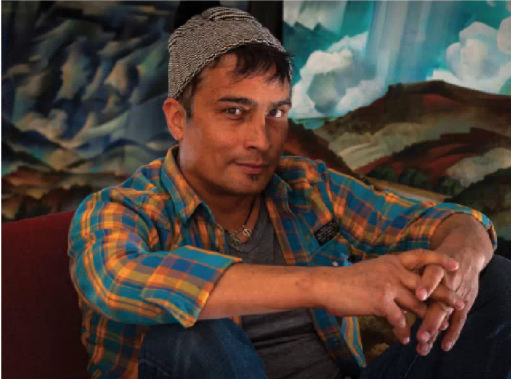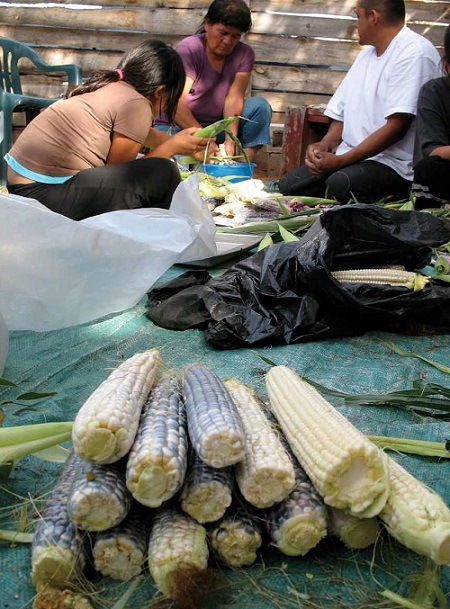 Heather Steinberger, Indian Country Today Media Network
Heather Steinberger, Indian Country Today Media Network
The modest studio, a second-story flat just off the plaza in Santa Fe, New Mexico, was a riot of color, images and media. Paintings and assemblages on paper perched in helter-skelter rows against the walls, a multipanel wooden piece rested in the middle of the floor, and easels stood in streaming shafts of morning light.
The artist responsible for all this scarcely stood still. Clad in a knit cap, plaid shirt and worn jeans, he looked like a young 20-something, still flush with the excitement of artistic experimentation and living a creative life. In actuality, Tony Abeyta is 47 and one of the most highly regarded contemporary painters working today. Last year, he earned the New Mexico Governor’s Award for Excellence in the Arts and was named a Living Treasure by Santa Fe’s Museum of Indian Arts & Culture. One of his murals adorns its gathering space, and a specially commissioned Abeyta painting was the signature image for the National Museum of the American Indian’s grand opening in Washington, D.C.
Abeyta has come a long way from his childhood in Gallup, New Mexico, where he grew up among Navajo, Zuni, Acoma and Laguna peoples. Yet even as a child, he says he was interested in creating—and in collaborating with others. “I was always making, creating, building. I also was into teamwork, manifesting new ideas with the other Navajo kids. We really did a lot of very creative art projects. Not painting, because we didn’t have any art supplies. It was more like salvage. My favorite show was Fat Albert [and the Cosby Kids] , and they always went to the dump!”
Trio in Song (oil and sand on canvas)
Abeyta also had ample inspiration at home. His father was a painter, and his mother worked with ceramics, so he was always surrounded by art. Although he doubted that he could build a career as an artist, he decided to take art classes in high school. “I had such curiosity,” he recalls. “I wanted to travel, to look at art. In the school library, I learned about the Flemish painters, the French Impressionists, the magic of people creating art.”
His sister was a student at the Institute of American Indian Arts in Santa Fe, and at the age of 16, Abeyta joined her there. He says he was blown away by the academic world: “There were supplies, easels, lights, fellow creative people. I was surrounded by artists from other nations. We were all in the studio, sharing ideas. School was all about community.”
Much of the student discussion then focused on the proper direction of American Indian art—Abeyta says politics and social responsibilities were deeply entrenched in Native art in the 1960s and 1970s. Then, in the 1980s, he says, the genre of Indian art really blossomed. “It was like wildfire. It became fashionable. Then it met its demise due to banality; it used the same images, the same stereotypes. A few artists, though, were interesting. There was the duality of traditionalism and contemporary vision. So, what was the next movement?”
Abeyta took classes at the institute for a year, but he soon realized that he needed to venture further afield. He says he felt an almost magnetic draw to immerse himself in something more mainstream than what he was doing in Santa Fe—to go beyond Indian art. “There were limitations on being Native and staying in New Mexico,” he explains. “I wanted to go to school back East. [The Maryland Institute College of Art in] Baltimore gave me a scholarship so I could attend tuition-free.”
Abeyta traveled to Baltimore and beyond. He studied at the Art Institute of Chicago and at the Haystack Mountain School of Crafts in Deer Isle, Maine. He also traveled overseas to study in southern France and in Florence, Italy. “It was an artistic Kerouac road trip!” he says, laughing. “I had no money. I’m amazed that I got through school—great schools—and traveled Europe.”
These travels and art-school experiences were critical for the young artist. “Artists just want to jump in and sell,” he explains. “They don’t want to learn the traditions [or] do the work. I saw such immense possibilities in how artists create. I was coming from a community where art follows traditional colors, images, themes, values. This was an opportunity to find and have a unique voice, one not limited by expectations. I wanted the artistic license to do whatever I wanted to do.
“The problem with Indian art is that people focus only on the Native experience, not on the universal human one,” he adds. “It’s too focused on tribal affiliation rather than on greater or similar cultural values throughout the world. And that’s what makes the world not lonely. Instead of always looking for differences, we should look at the similarities. We’d wake up amazed.”
Abeyta earned his master’s degree in fine art from New York University. Today, he splits his time between Santa Fe, where he is represented by the Blue Rain Gallery, and Chicago, where his son, Gabriel, 22, lives and works as a filmmaker. (His daughter, who is 15, hopes to be an installation artist.) He maintains a studio in both places.
After more than three decades as an artist, he continues to experiment with his media—including oils, charcoal, sand and even jewelry—as well as with his techniques, images, patterns, colors and style. Now in what he calls the middle range of his career, Abeyta says he’s even more careful about refining his work and making sure that it doesn’t become predictable: “[Art] is about making a contribution to culture, about being part of the creative dialogue. Without that, you run the risk of banality. I don’t shortchange the art; I don’t whip things out. I did when I was younger. Now, I might work on a painting for a year—because now, everything is part of my legacy.”
While he remains passionate about his life as an artist, he’s equally passionate about supporting the native arts community and younger artists who are just embarking on their careers. Not only has he donated work to local and national charities and served on the Museum of Indian Arts & Culture development committee, he is an adjunct professor at Institute of American Indian Arts. “I do the fall semester, then take off in the spring. I start with the basics: drawing. That’s the foundation for everything, from painting and sculpture to fashion and architecture.”
When asked about his motivation for teaching, Abeyta pauses, then says he hopes the younger generation can benefit from his experience: “I tell them, back up, don’t run. Develop the artwork before you show it. I know this from experience. I started showing and selling my work at 20; that’s when I quit my job. But selling paintings is a futile spiritual endeavor. You go down that road, and you find yourself saying, ‘I’ve paid the rent, I’ve paid for my car. Why am I so unhappy?’
“So I teach. I’m not interested in the commercial part. I provide direction on content, techniques, and I guide them to slow down. People respond to the work if you’re passionate about it, so you have the responsibility to do the best work you can. Be original.”
Yei: Creating (oil on canvas)
Abeyta remains busy with large neomodernist landscapes; black-and-white, abstract, biomechanical, charcoal-and-ink wash drawings that he mounts on Japanese paper; and multipanel wooden pieces that depict ancestral, spiritual figures. “I love working with wood. Color is really important. I’ve kept informing it, creating something sculptural. These paintings really do transform into walls sculptures.”
When he does pause to reflect on a career that is admittedly quite accomplished, Abeyta says a couple of highlights come to mind. One is the 2004 opening of the Smithsonian’s National Museum of the American Indian. “They [commissioned] a big multipanel piece and blew it up into huge banners,” he recalls. “There were 100,000 people, and these banners on the National Mall; the work also was on press passes, VIP passes, posters, T-shirts. All pieces of my painting. It was surreal.”
The painting now resides in the Smithsonian. Other museum collections containing Abeyta’s work include the Heard Museum of Art, Millicent Rogers Museum, Museum of Indian Arts & Culture and Wheelwright Museum of the American Indian.
The second highlight was a recent e-mail from the president of the Institute of American Indian Arts. “I’m getting an honorary doctorate for all of my contributions,” Abeyta marvels. “That’s a really big deal!” Laughing, he adds, “I should be a waiter.”
Abeyta is grateful for the journey that has taken him to so many places around the world and connected him with intriguing people from all walks of life. “Art has been the vehicle,” he says. “It’s not me, though. I’m not part of it. People respond to the work. I just do it to the best of my ability.”
He doesn’t dwell on accolades or his accomplishments, however. His eyes are firmly planted on the work. “I love what I’m doing now. I’m still excited to come into the studio, so the here-and-now is pretty good. [But] I’d like to move toward more figurative subjects. So, the next decade is about refining what I do. I’d like to move somewhere—to look with a different eye.”
His artistic journey, he explains, remains one of discovery. “At the end of it all is the spiritual. Artists can have the skill, the movements, the rhythm. But the spiritual part of it is the meat-and-potatoes of why we’re here.”
Read more at https://indiancountrytodaymedianetwork.com/2013/06/11/native-artist-tony-abeyta-talks-inspiration-and-aspirations-149830













![Susanne Patles in prayer, as New Brunswick RCMP confer. [Photo: M. Howe]](http://www.tulalipnews.com/wp/wp-content/uploads/2013/06/img_7549.jpg)


